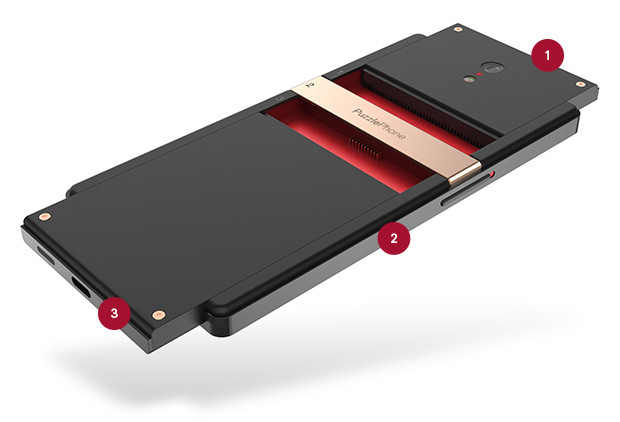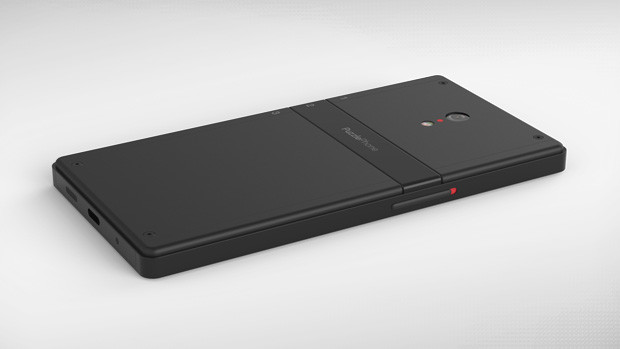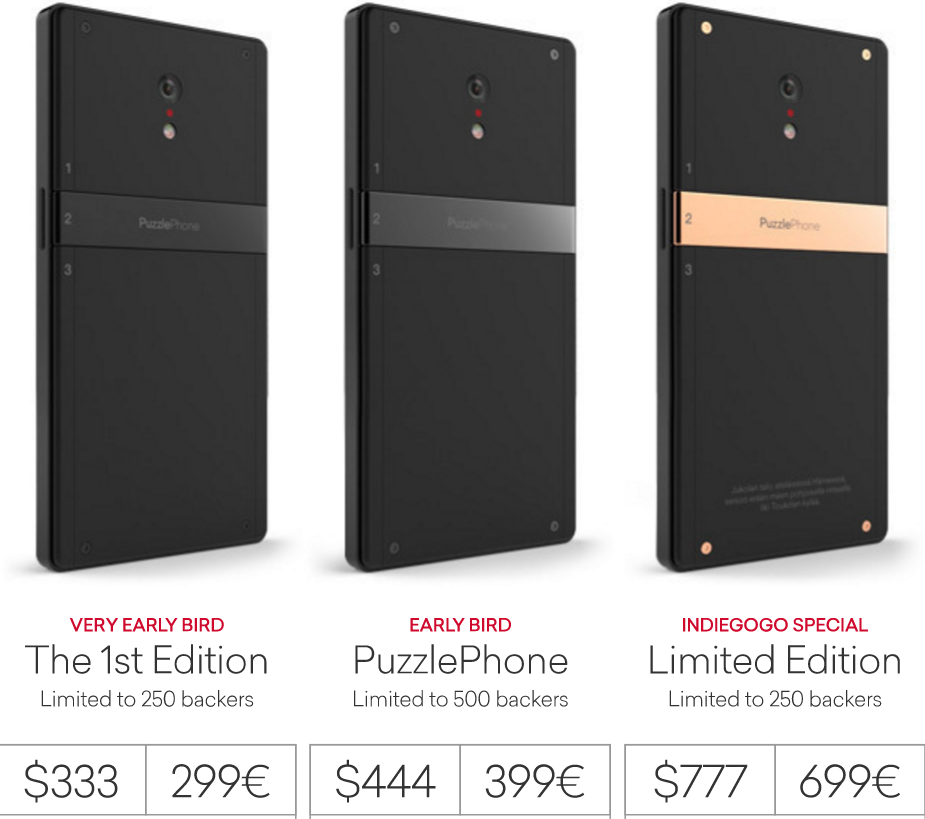PuzzlePhone Picture Emerges As $333 Modular Smartphone Lands On Indiegogo (Update: MicroSD Support)
Although Project Ara is the most prominent modular smartphone project at present, and stands the greatest chance of success by dint of being funded by Alphabet (formerly Google), it's by no means the only game in town. Upstart Circular Devices, maker of the PuzzlePhone, just launched an Indiegogo campaign to get its own modular device funded and out to the masses.
We first heard about the intriguing PuzzlePhone nearly a year ago when it emerged as little more than a concept, with its simpler take on modularity: the spine, the heart and the brain. In March of this year, we got under the hood a bit by learning that the PuzzlePhone was being developed in partnership with another modular mobile project, the Click ARM One tablet (by ImasD Technologies).
Fast forward several months, and we have actual PuzzlePhone handsets ready for a groundswell of crowdfunded support.
What's Inside The First PuzzlePhone
The PuzzlePhone is comprised of three basic parts: the brain, the spine and the heart.
The brain has the CPU, GPU, RAM, storage and camera. The spine is the "structure of the device" and houses the display, and the heart houses all the "secondary electronics," including the antenna (etc.), as well as the battery.
The idea here is that you may want to upgrade parts of your smartphone at a certain time, but wait on others. For example, your SoC may be out of date within a couple of years (or sooner), but that 1920 x 1080 display could be sufficient for years.
Circular Devices stated that the phone is designed to last up to 10 years. That seems awfully far-fetched, but even conservatively speaking, this concept could grant your handset significantly longer life than you get out of a phone today. Think of it this way: When you upgrade your PC, you upgrade a few parts at a time. Even if you perform a total platform overhaul, such as an upgrade to Skylake (new motherboard, new CPU, new RAM), you don't necessarily want to pitch your case, GPU and PSU.
Get Tom's Hardware's best news and in-depth reviews, straight to your inbox.
The company did not specify what SoC the brain will have just yet beyond describing it as "ARM 64 bits, 8 cores," but the device will have a 5-inch FHD display, 4G LTE connectivity, and a USB Type-C interface. It's unclear what speed the connector will offer, but because it's listed as "USB 3.0," we presume it's just 5 Gbps.
There is no mention of a microSD slot, which is unfortunate, although storage hogs should find solace in the 64 GB model.
| SoC | "ARM 64 bits, 8 cores" |
|---|---|
| Display | -5-inch-Full HD (1920x1080) |
| RAM | 3 GB |
| Storage | 16, 32, and 64 GB models |
| Cameras | -Front: 5MP-Rear: 12MP, with LED flash |
| Connectivity | -2G/3G/4G/LTE Cat4/6 (depending on markets)-USB 3.0/2.0 Type-C-NFC + Bluetooth LE 4.2-Wi-FI 802.11 a/b/g/n/ac-GPS |
| Battery | 2,800 mAh |
| Sensors | -Accelerometer-Gyroscope-Proximity-Ambient light |
| Materials | -Molded black plastic (16 GB model)-Gun metal "logo plate detail," red accents (32 GB model)-"Copper details," engraved special edition cover plate (64 GB model) |
| Dimensions | 69 x 137 x 8.9 mm |
| Weight | 170g |
| Accessories | -USB Type-C charger-Headphones with integrated mic |
| OS | Android 6.0 Marshmallow (and above) |
| Price | -$333 (16 GB, Sept. 2016)-$444 (32 GB, Oct. 2016)-$777 (64 GB, Oct. 2016) |
Circular Devices was somewhat vague in describing the PuzzlePhone's materials; the first one will be molded black plastic, and the subsequent larger storage capacity editions will add metal and red-colored accents, although it seems that they'll also fundamentally be made of black plastic.
What's Coming And When
Circular Devices currently has a bulky white-and-silver prototype (a hack of a "well known smartphone"), as well as a much more svelte and attractive black final design.
Those excited about the final PuzzlePhone have a while to wait; the 16 GB PuzzlePhone won't arrive until September 2016. The 32 GB and 64 GB handsets are slated to land the following month.
From the company's schedule, it looks like the first builds will occur early in 2016, with a second build beginning in Q1 as well. Mass production will begin in Q3 2016, just before the first PuzzlePhones arrive on early bird supporters' doorsteps.
Circular Devices hopes to raise $250,000 to proceed with its work. Presently, after 12 hours, backers have contributed over $30,000.
Evolution Versus Revolution
Circular Devices' approach here is probably more sensible, though less ambitious and ostentatious, than Project Ara. Whereas Project Ara is an attempt to completely revolutionize the handset market, the PuzzlePhone is more of an evolution. Many new flagship smartphones today eschew removable batteries, for example, which is a development that seems deeply unpopular among a significant number of users.
Circular Devices is moving in the opposite direction. It's asking why would we want such a locked-down phone. Why do we want to toss out that $800 handheld computer every year or so just to get the slightly better version? (A smaller but no less important part of the company's ethos seems to be a push back against the culture of disposability not just because of the silliness of it, but because it can be an environmental issue.)
In the company's video on Indiegogo, Circular Devices CEO Alejandro Santacreu made his case: "By supporting us, you will be triggering the paradigm shift from 'take, make, dump' to 'upgrade, reuse and recycle.'" In a winking jab, he ended with, "We are the androids you have been waiting for."
Update, 11/9/15, 11:25am PT: Circular Devices announced that PuzzlePhone will now offer microSD support. The emailed announcement reads in part, "We have great news today! We are happy to announce the first free upgrade for all present and future backers ...now all PuzzlePhone models offered in this Indiegogo crowdfunding campaign will have microSD support." The company said that its engineering team figured out how to "enhance the Brain electronics and stuffed inside the support for microSD."
There was no further explanation, but we infer that this means microSD support should become standard (or at least generally available) on PuzzlePhone handsets going forward.
______________________________________________________________________
Seth Colaner is the News Director at Tom's Hardware. He curates and edits the news channel and also writes on a variety of topics. He would have become a professional ultimate Frisbee player, but he was born 15 years too early.
Follow him on Twitter @SethColaner. Follow us on Facebook, Google+, RSS, Twitter and YouTube.
Seth Colaner previously served as News Director at Tom's Hardware. He covered technology news, focusing on keyboards, virtual reality, and wearables.
-
Bloob I like this concept far better than Project Ara (which is imo too complex). The problem with these modular phones is the need for a relatively static design and dimensions, but I might get one anyway.Reply -
Jeremy Kincaid Jesus, that price increase for more storage is insane. $111 more for 16gb more storage, then $333 more for 32gb more?! Kinda takes away from the whole modular concept when you have to pay outrageously for more storage instead of paying like 70 bucks for a (modular?) microsd. The appeal of modular phones is to not overpay to get what you need as part of a bundled price (like when they give you more ram to go with more storage when all you really want is more storage.) I'll keep my eye on project ARA which is, like, ACTUALLY modular, instead of this first party only upgrade they look to be doing, correct me if I'm wrong. ARA has the potential to turn phones into better tools with modules serving whatever purpose you can fit on there,with modules made by whatever company wants to get involved. I picture in the future doctors having a phone with like some x-ray camera on it or a computer repair technician having a module that pops out a little powered screwdriver. And if your little screwdriver module breaks? Just replace THAT SPECIFIC PART instead of half the phone. This is just a boring half-step towards modulation that they try to pass off as being more sensible. You'd be better off with a 300 dollar phone with an sd slot.Reply -
scolaner Reply16892308 said:Jesus, that price increase for more storage is insane. $111 more for 16gb more storage, then $333 more for 32gb more?! Kinda takes away from the whole modular concept when you have to pay outrageously for more storage instead of paying like 70 bucks for a (modular?) microsd. The appeal of modular phones is to not overpay to get what you need as part of a bundled price (like when they give you more ram to go with more storage when all you really want is more storage.) I'll keep my eye on project ARA which is, like, ACTUALLY modular, instead of this first party only upgrade they look to be doing, correct me if I'm wrong. ARA has the potential to turn phones into better tools with modules serving whatever purpose you can fit on there,with modules made by whatever company wants to get involved. I picture in the future doctors having a phone with like some x-ray camera on it or a computer repair technician having a module that pops out a little powered screwdriver. And if your little screwdriver module breaks? Just replace THAT SPECIFIC PART instead of half the phone. This is just a boring half-step towards modulation that they try to pass off as being more sensible. You'd be better off with a 300 dollar phone with an sd slot.
I don't disagree about the storage price markup. I think some of that cost comes from materials, too...? But anyway, right, it's not clear what the full benefits would be from the $333 version to the one that costs more than double.
Do note, though, that Circular Devices wants to make this a third-party module thing. I mentioned that in the copy at one point.
I'm optimistic about Ara, but the project seems plagued by all sorts of issues. Delays, tech issues, leadership changes. They cancelled the Puerto Rico pilot. http://www.tomshardware.com/news/project-ara-no-magnets-2016,29890.html
I agree that PuzzlePhone is less compelling than Ara, but it seems more feasible. And that's the thing to excited about, IMHO. -
g-unit1111 I like the idea of this phone - my biggest question is carrier availability. Especially here in the US where that's very important. If they could make a CDMA version that's compatible with Sprint and Verizon, this thing could sell like hotcakes, if they lowered the price of course.Reply -
Bloob ReplyJesus, that price increase for more storage is insane. $111 more for 16gb more storage, then $333 more for 32gb more?! Kinda takes away from the whole modular concept when you have to pay outrageously for more storage instead of paying like 70 bucks for a (modular?) microsd. The appeal of modular phones is to not overpay to get what you need as part of a bundled price (like when they give you more ram to go with more storage when all you really want is more storage.)
I could be wrong here, but I think there are more changes than just the storage, and the most expensive one (limited edition) seems to be for fans / supporters. -
dezonio2 The article completely forgot to mention the fact that the company is from Espoo, Finland. At the very least they won't have a shortage of talent there.Reply






